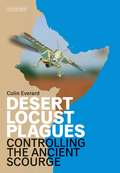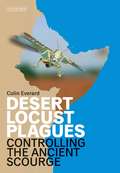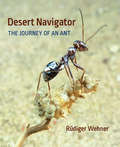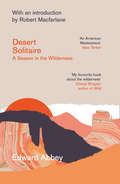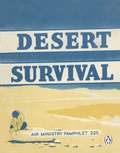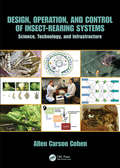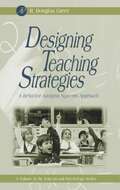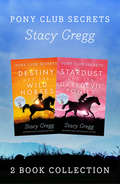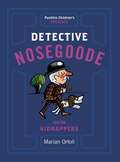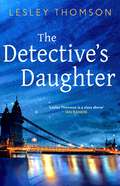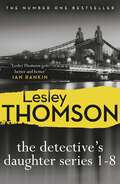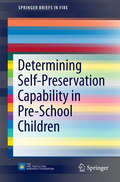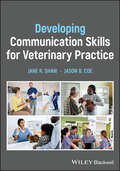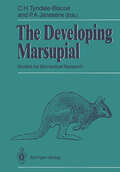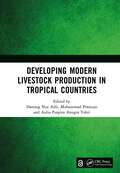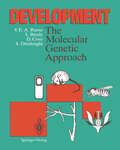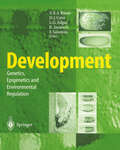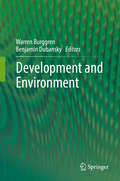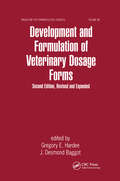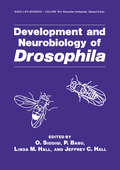- Table View
- List View
Desert Locust Plagues: Controlling the Ancient Scourge
by Robert A. Cheke Colin EverardFor thousands of years, humans have found themselves vulnerable to plagues of desert locusts. Some fifty countries in Africa, the Middle East and Asia have been ravaged, at one time or another, by huge, devouring swarms of locusts. With the consequent, often total, destruction of crops and grazing, widespread hunger and starvation ensued. Colin Everard's book takes as its geographical focus the Horn of Africa, an area which throughout history has suffered catastrophically from locust plagues. Based on his own extensive experience in the region, Everard describes one of the greatest (albeit unsung) triumphs of the twentieth century, namely, how the desert locust scourge has, at last, been virtually brought under control.
Desert Locust Plagues: Controlling the Ancient Scourge
by Colin Everard Robert A. ChekeFor thousands of years, humans have found themselves vulnerable to plagues of desert locusts. Some fifty countries in Africa, the Middle East and Asia have been ravaged, at one time or another, by huge, devouring swarms of locusts. With the consequent, often total, destruction of crops and grazing, widespread hunger and starvation ensued. Colin Everard's book takes as its geographical focus the Horn of Africa, an area which throughout history has suffered catastrophically from locust plagues. Based on his own extensive experience in the region, Everard describes one of the greatest (albeit unsung) triumphs of the twentieth century, namely, how the desert locust scourge has, at last, been virtually brought under control.
Desert Navigator: The Journey of the Ant
by Rüdiger WehnerCataglyphis ants can set out across vast expanses of desert terrain in search of prey, and then find the shortest way home. Rüdiger Wehner has devised elegant experiments to unmask how they do it. Through a lively and lucid narrative, he offers a firsthand look at the extraordinary navigational skills of these charismatic creatures.
Desert Solitaire: A Season In The Wilderness
by Edward Abbey‘My favourite book about the wilderness’ Cheryl Strayed, author of Wild In this shimmering masterpiece of American nature writing, Edward Abbey ventures alone into the canyonlands of Moab, Utah, to work as a seasonal ranger for the United States National Park Service.
Desert Survival (Air Ministry Survival Guide)
by A.M. Pamphlet 225THE ULTIMATE SURVIVAL GUIDE for anyone who thinks they'd survive the world's most hostile environments - or at least imagine they could do.-----------------------------First issued to airmen in the 1950s, the Air Ministry's Sea Survival guide includes original and authentic emergency advice to crew operating over the ocean. With original illustrations and text, these survival guides provide an insight to military survival techniques from a by-gone era.Packed with original line drawings and instruction in:- How to find water in a dry stream course- How to make a hat out of seat cushions- What to do in the event of meeting 'hostile parties'Focussing on one of the most unforgiving environments on Earth, Desert Survival is one of four reprints of The Air Ministry's emergency survival pamphlets. Others include:· Jungle Survival· Sea Survival· Arctic Survival
Design, Operation, and Control of Insect-Rearing Systems: Science, Technology, and Infrastructure
by Allen Carson CohenDesign, Operation, and Control of Insect-Rearing Systems: Science, Technology, and Infrastructure explains the fundamental components of insect rearing: 1) the rearing systems, per se 2) personnel 3) education of rearing personnel 4) communication of procedures 5) an in-depth look at silkworm rearing 5) facilities where rearing is conducted, and 6) funding for all these components. Insect rearing serves a wide array of purposes, including research, pest control by sterile insect technique and biological control, production of insects as food for other animals, conservation, education, and even far-reaching technology where insects are used to produce products such as pharmaceutical materials and strong, multipurpose textiles. This book surveys and analyzes insect rearing from a scientific and technology-based approach. At its foundation, this approach assumes that rearing systems are complex interactions of components that can be understood and controlled by using a mechanistic approach. Author Allen Carson Cohen explains the infrastructure of rearing systems, their current status and character, and what kind of changes can be made to improve the field of insect rearing. Two Appendices republish out-of-print monographs that provide fascinating historical context to the development of the insect-rearing systems we have today.
Design, Operation, and Control of Insect-Rearing Systems: Science, Technology, and Infrastructure
by Allen Carson CohenDesign, Operation, and Control of Insect-Rearing Systems: Science, Technology, and Infrastructure explains the fundamental components of insect rearing: 1) the rearing systems, per se 2) personnel 3) education of rearing personnel 4) communication of procedures 5) an in-depth look at silkworm rearing 5) facilities where rearing is conducted, and 6) funding for all these components. Insect rearing serves a wide array of purposes, including research, pest control by sterile insect technique and biological control, production of insects as food for other animals, conservation, education, and even far-reaching technology where insects are used to produce products such as pharmaceutical materials and strong, multipurpose textiles. This book surveys and analyzes insect rearing from a scientific and technology-based approach. At its foundation, this approach assumes that rearing systems are complex interactions of components that can be understood and controlled by using a mechanistic approach. Author Allen Carson Cohen explains the infrastructure of rearing systems, their current status and character, and what kind of changes can be made to improve the field of insect rearing. Two Appendices republish out-of-print monographs that provide fascinating historical context to the development of the insect-rearing systems we have today.
Designing Teaching Strategies: An Applied Behavior Analysis Systems Approach (ISSN)
by R. Douglas GreerThe US Dept. of Education, in conjunction with the US Dept. of Health and Human Services, recently unveiled a $50 million effort to expand research on early childhood cognitive development. A key issue identified requiring more information and research was the education and professional development of educators. Along these lines, Doug Greer has prepared a book discussing how best to teach, how to design functional curricula, and how to support teachers in using state-of-the-art science instruction materials. The book provides important information both to trainers of future teachers, current teachers, and to supervisors and policy makers in education. To trainers there is information on how to motivate, mentor, and instruct in-service teachers to use the best scientifically based teaching strategies and tactics. To in-service teachers, there is information on how to provide individualized instruction in classrooms with multiple learning and behavior problems, school interventions to help prevent vandalism and truancy, and how curricula and instruction can be designed to teach functional repetoirs rather than inert ideas. To policy makers and supervisors, the book discusses how to determine the effectiveness of curricular innitiatives toward meeting mandated standards in national assessments.Doug Greer was recently awarded the Fred S. Keller Award for Distinguished Contributions to Education by APA for the research and application of the material covered in this book. School programs incorporating the material used in this book have produced 4-7 times more learning outcomes for students than control and baseline educational programs (see www.cabas.com)The book provides research-based and field-tested procedures for:* Teaching students of all ability levels ranging from preschool to secondary school* How to teach special education students in the context of a regular classroom* Best practices for all teachers to teach more effectively* Means of monitoring and motivating teachers' practices* A comprehensive and system-wide science of teaching—post modern-postmodern!* Tested procedures that result in four to seven times more learning for allstudents* Tested procedures for supervisors to use with teachers that result insignificant student learning* Tested procedures for providing the highest accountability* A systems approach for schooling problems that provide solutions ratherthan blame* Parent approved and parent requested educational practices* Means for psychologists to work with teachers and students to solvebehavior and learning problems* A comprehensive systems science of schooling* An advanced and sophisticated science of pedagogy and curriculum design* Students who are not being served with traditional education can meet orexceed the performance of their more fortunate peers,* Supervisors can mentor teachers and therapists to provide state of thescience instruction* Parent education can create a professional setting for parents, educators,and therapists to work together in the best interests of the student,* Teachers and supervisors who measure as they teach produce significantlybetter outcomes for students,* Systemic solutions to instructional and behavioral problems involvingteachers, parents, supervisors provide means to pursue problems to theirsolution,* A science of teaching, as opposed to an art of teaching, can provide aneducational system that treats the students and the parents as the clients.
Destiny and Stardust (Pony Club Secrets)
by Stacy GreggSummer special chunky read 2-in-1 edition of the third and fourth books in the ‘Pony Club Secrets’ series: ‘Destiny and the Wild Horses’ and ‘Stardust and the Daredevil Ponies’.
Destiny and the Wild Horses (Pony Club Secrets #3)
by Stacy GreggThe third gripping adventure in this exciting new pony-club series. With gymkhanas to win, rivals to defeat, mysteries to solve and ponies in danger to save – these books are perfect for all girls who love ponies.
Detective Nosegoode and the Kidnappers
by Marian OrłońThe second in a series of irresistibly charming, beautifully illustrated children's classics - the adventures of Detective Nosegoode and his talking dog, CodyDetective Nosegoode is very proud that his faithful hound Cody makes an appearance in the new book Portraits of Extraordinary Dogs.But with Cody’s newfound fame as ‘the world’s most extraordinary dog’ comes danger... A mysterious letter arrives, inviting Detective Nosegoode to a meeting at the secluded Birch Grove, and when he returns his canine companion is nowhere to be found!Detective Nosegoode immediately sets to work, determined to use his legendary sleuthing skills to track down the culprits and save his friend. But the puzzle is a tricky one. Who are the mysterious letter- writers? Why have they taken Cody? And, most importantly of all, where are they hiding him?This charmingly illustrated classic of children’s literature is part of the Detective Nosegoode series.Marian Orłoń (1932-1990) worked as a teacher, and then a librarian while pursuing an extremely successful career as a children’s writer. His subtle sense of humour and exciting plots made the stories in his Detective Nosegoode series bestsellers in Poland. His books have now been translated into six languages. In 1981 he was given Poland’s highest literary honour, the Council of Ministers Award, for his life’s work.
The Detective's Daughter: A gripping Sunday Times crime club thriller to lose yourself in (The Detective's Daughter #1)
by Lesley ThomsonAs winter closes its grip on snow-bound London, a cleaner determines to solve the case that her detective father never could. A Kindle number one bestseller. It was the murder that shocked the nation. Kate Rokesmith, a young mother, walked to the banks of the Thames with her three-year-old son. She never came home.For three decades, the case file has lain, unsolved, in the corner of an attic. Until the detective's daughter, Stella Darnell, starts to clear out her father's house after his death...Reviews for The Detective's Daughter: 'A haunting novel about loss and reconciliation, driven by a simple but clever plot' Sunday Times 'This book has a clever mystery plot – but its excellence is in the characters, all credible and memorable, and in its setting in a real West London street, exactly described' Literary Review 'A thoughtful, well-observed story... It reminded me of Kate Atkinson' Scott Pack 'A cerebral thriller... Evokes chills from more than just the frigid winter nights' Forward Reviews Magazine 'Lesley Thomson gets better and better' Ian Rankin
The Detective's Daughter Series Boxset (The Detective's Daughter)
by Lesley ThomsonA complete e-Book boxset of the novels in Lesley Thomson's bestselling Detective's Daughter series.Stella Darnell, a cleaner, is the detective's daughter. When her father died, she discovered old case files in his attic while clearing out his house. Now she has devoted herself to solving crimes that were once thought unsolvable, assisted by her friend Jack, a tube driver.Follow Stella and Jack's story with this complete eBook boxset, including books 1–8:The Detective's Daughter Ghost Girl The Detective's Secret The House with No Rooms The Dog Walker The Death Chamber The Playground MurdersThe Distant Dead The first novel in the series, The Detective's Daughter, became an ebook phenomenon in 2013, staying at number 1 in the digital charts for 3 months. Since then, the series has gone on to sell 800,000 copies worldwide.'Lesley Thomson is a class above' Ian Rankin'Stella Darnell is without doubt one of the most orginial characters in British crime fiction'Crime Review
Determining Self-Preservation Capability in Pre-School Children (SpringerBriefs in Fire)
by Anca Taciuc Anne S. DederichsThis SpringerBrief explores the evacuation characteristics of children and their self-preservation capability during fire situations. An international survey among teachers from day-care centers and experts in child development indicates an age-limit at which pre-school children may be considered capable of evacuating a location without direct intervention by an instructor. The survey examines the ability of children to understand and follow simple instructions, walk on horizontal surfaces without physical support, and walk down stairs. It also studies how fire safety installations and fire drills differ between countries. A literature review and a presentation of the method applied are included. This data can be applied to evacuation procedures, building codes, and fire regulations. Determining Self-Preservation Capability in Pre-School Children is intended for practitioners as a tool for analyzing evacuation safety issues and developing methods removing potential hazards. Researchers working in a related field will also find the book valuable.
Developing Communication Skills for Veterinary Practice
by Jane R. Shaw Jason B. CoeDeveloping Communication Skills for Veterinary Practice Developing Communication Skills for Veterinary Practice provides a thorough grounding in practical communication principles for client and team interactions, and helps veterinarians and staff take their communication skills to the next level through self-development and coaching colleagues. The book describes specific evidence-based techniques, gives examples of their use, and demonstrates how to use each skill in the clinical setting, with learning activities to put into practice. It covers every mode of communication, including face-to-face, virtual, telephone, and written communication. Organized by the tasks of the clinical appointment, each chapter showcases specific communication skills. The book introduces a communication toolbox of 20 key communication skills, which can be applied to any area of veterinary practice or veterinary career path. The book: Defines each communication skill, demonstrates techniques, and provides examplesEmphasizes the importance of communicating effectively with clients and colleaguesProvides a process and structure for coaching communication with colleaguesDiscusses client and team interactions using many methods, including in-person meetings, telephone conversations, and emailsOutlines best practices for effectively communicating using technology Developing Communication Skills for Veterinary Practice is an invaluable resource for veterinary professionals at any level seeking to develop their communication skills and improve clinical outcomes.
Developing Communication Skills for Veterinary Practice
by Jane R. Shaw Jason B. CoeDeveloping Communication Skills for Veterinary Practice Developing Communication Skills for Veterinary Practice provides a thorough grounding in practical communication principles for client and team interactions, and helps veterinarians and staff take their communication skills to the next level through self-development and coaching colleagues. The book describes specific evidence-based techniques, gives examples of their use, and demonstrates how to use each skill in the clinical setting, with learning activities to put into practice. It covers every mode of communication, including face-to-face, virtual, telephone, and written communication. Organized by the tasks of the clinical appointment, each chapter showcases specific communication skills. The book introduces a communication toolbox of 20 key communication skills, which can be applied to any area of veterinary practice or veterinary career path. The book: Defines each communication skill, demonstrates techniques, and provides examplesEmphasizes the importance of communicating effectively with clients and colleaguesProvides a process and structure for coaching communication with colleaguesDiscusses client and team interactions using many methods, including in-person meetings, telephone conversations, and emailsOutlines best practices for effectively communicating using technology Developing Communication Skills for Veterinary Practice is an invaluable resource for veterinary professionals at any level seeking to develop their communication skills and improve clinical outcomes.
The Developing Marsupial: Models for Biomedical Research
by C. H. Tyndale-Biscoe P. A. JanssensMarsupials are excellent objects for studies on developmental processes in all mammals including humans. Marsupials are very immature at birth and undergo most of their development in a pouch where they can be manipulated in a variety of ways without affecting the mother. Most of these studies are on systems which largely mature before birth in eutherian mammals and are consequently difficult to investigate. Attention is also drawn to certain features peculiar to adult marsupials: e.g., they continue to grow throughout adult life, valuable for studies on growth mechanisms, and furthermore the composition of marsupial milk changes radically through lactation, most important in studies of hormonal regulation of milk composition and secretion.
Developing Modern Livestock Production in Tropical Countries: Proceedings of the 5th Animal Production International Seminar (APIS 2022), Malang, Indonesia, 10 November 2022
by Danung Nur Adli Muhammad Pramujo Anugra Yekti, Aulia PuspitaThe Animal Production International Seminar (APIS) is the first international conference held by the Faculty of Animal Science, Universitas Brawijaya. APIS was held for the first time in 2010 and was repeated every three years. In 2022, the 5th APIS was organized as an online meeting. The Faculty of Animal Science, Universitas Brawijaya, is optimistic that the results of the 5th APIS will just be as successful as the 4th APIS in 2019. The theme of 5th APIS was "Developing Modern Livestock Production in Tropical Countries". The 5th APIS discussed matters related to strategies for developing modern livestock production in several tropical countries. The participants of 5th APIS, including keynote speakers and invited speakers, are from various countries (tropical and sub-tropical). These proceedings present the selected papers from the 5th APIS conference.
Developing Modern Livestock Production in Tropical Countries: Proceedings of the 5th Animal Production International Seminar (APIS 2022), Malang, Indonesia, 10 November 2022
The Animal Production International Seminar (APIS) is the first international conference held by the Faculty of Animal Science, Universitas Brawijaya. APIS was held for the first time in 2010 and was repeated every three years. In 2022, the 5th APIS was organized as an online meeting. The Faculty of Animal Science, Universitas Brawijaya, is optimistic that the results of the 5th APIS will just be as successful as the 4th APIS in 2019. The theme of 5th APIS was "Developing Modern Livestock Production in Tropical Countries". The 5th APIS discussed matters related to strategies for developing modern livestock production in several tropical countries. The participants of 5th APIS, including keynote speakers and invited speakers, are from various countries (tropical and sub-tropical). These proceedings present the selected papers from the 5th APIS conference.
Development: The Molecular Genetic Approach
by Vincenzo E.A. Russo Stuart Brody David Cove Sergio OttolenghiAs a result of the molecular genetic analysis of development similar mechanisms for the regulation of gene expression are found in a wide range of organisms. In "Development - the Molecular Genetic Approach" these common mechanisms as well as the specific events leading to a differentiated cell are described. Particular items treated are, for example, how asymmetry is achieved, how cell size is determined, how cell division is controlled, how cell lineage influences development, how cells know their position, and how cells communicate during development.
Development: Genetics, Epigenetics and Environmental Regulation
by F. Salamini V. E. A. Russo D. J. Cove L. G. Edgar R. JaenischStudies of organisms have led to a greatly improved understanding of the genetic mechanisms underlying developmental processes, and the epigenetic and environmental influences on these processes. This second edition reviews these three levels and their relative importance to give the reader a clear picture of one of the most exciting areas of current biological research.
Development and Environment
by Benjamin Dubansky Warren BurggrenRather than a loosely connected list of facts/topics, this book addresses virtually every field that involves the use of developing animals in environmental science. In doing so, it will help define the scientific collective within these fields to both those readers who are "outside" of a particular field (students and professionals alike) and those who work within said field, where multiple iterations of the same job description exist. Both the content and choice of authors fully support this goal, as the editors and contributing authors represent contemporary thought and experimentation in their respective fields – ranging from developmental physiology through environmental toxicology to medicine. As such, this work will appeal to a broad audience, including any scientist or trainee interested in the nexus of environment, development and physiology.
Development and Formulation of Veterinary Dosage Forms
by Gregory E. Hardee; J. Desmond BaggotAlthough the United States (U.S.) and the more developed nations of the remainder of the world are blessed with a variety of pharmaceuticals, feed additives, and biological products to treat, prevent, and control animal diseases, there is a healthy desire among persons involved in animal health issues to increase our animal medicine chest. The interest stems from the desire to efficiently produce food that is safe and plentiful and from the desire to have more and better government-approved products available for the prevention and treatment of diseases of dogs, cats, and horses and for an increasing variety of minor animal species. For the animal health industry, increased drug availability means broader markets, increased revenues, and an opportunity to better serve their customers. For the veterinarian, more animal health products means that he or she is better able to treat the usual and the unusual conditions, and to prevent animal disease and suffering. No doubt, we are all winners when new technology and industrial and regulatory initiatives hasten the availability of safe and effective animal health products.
Development and Formulation of Veterinary Dosage Forms (Drugs And The Pharmaceutical Sciences Ser.)
by Gregory E. Hardee J. D. BaggotAlthough the United States (U.S.) and the more developed nations of the remainder of the world are blessed with a variety of pharmaceuticals, feed additives, and biological products to treat, prevent, and control animal diseases, there is a healthy desire among persons involved in animal health issues to increase our animal medicine chest. The interest stems from the desire to efficiently produce food that is safe and plentiful and from the desire to have more and better government-approved products available for the prevention and treatment of diseases of dogs, cats, and horses and for an increasing variety of minor animal species. For the animal health industry, increased drug availability means broader markets, increased revenues, and an opportunity to better serve their customers. For the veterinarian, more animal health products means that he or she is better able to treat the usual and the unusual conditions, and to prevent animal disease and suffering. No doubt, we are all winners when new technology and industrial and regulatory initiatives hasten the availability of safe and effective animal health products.
